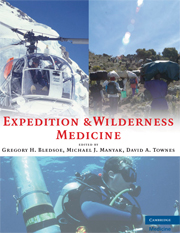Book contents
- Frontmatter
- Contents
- Contributors
- Foreword
- Preface
- Acknowledgments
- PART I EXPEDITION PLANNING
- PART II EXPEDITIONS IN UNIQUE ENVIRONMENTS
- PART III ILLNESS AND INJURIES ON EXPEDITIONS
- 24 General Medical
- 25 The Diarrhea of Travelers
- 26 Malaria: Diagnosis, Prevention, and Treatment for the Traveler
- 27 Wild Animal Attacks and Injuries
- 28 Snake and Arthropod Envenoming
- 29 Hazardous Marine Life
- 30 Expedition Toxicology
- 31 Environmental Injuries
- 32 Penetrating and Explosive Wounds
- 33 Drowning and Submersion Injury
- 34 Evaluation and Acute Resuscitation of the Trauma Patient
- 35 Principles and Practice of Expedition Wound Management
- 36 Expedition Eye Injuries and Disorders
- 37 Dental Medicine on Expedition
- 38 Foot Injuries
- 39 Expedition Orthopedics
- 40 Expedition Self-Rescue and Evacuation
- 41 Aeromedical Evacuations
- APPENDIX The Expedition Medical Kit
- Index
41 - Aeromedical Evacuations
from PART III - ILLNESS AND INJURIES ON EXPEDITIONS
Published online by Cambridge University Press: 05 March 2013
- Frontmatter
- Contents
- Contributors
- Foreword
- Preface
- Acknowledgments
- PART I EXPEDITION PLANNING
- PART II EXPEDITIONS IN UNIQUE ENVIRONMENTS
- PART III ILLNESS AND INJURIES ON EXPEDITIONS
- 24 General Medical
- 25 The Diarrhea of Travelers
- 26 Malaria: Diagnosis, Prevention, and Treatment for the Traveler
- 27 Wild Animal Attacks and Injuries
- 28 Snake and Arthropod Envenoming
- 29 Hazardous Marine Life
- 30 Expedition Toxicology
- 31 Environmental Injuries
- 32 Penetrating and Explosive Wounds
- 33 Drowning and Submersion Injury
- 34 Evaluation and Acute Resuscitation of the Trauma Patient
- 35 Principles and Practice of Expedition Wound Management
- 36 Expedition Eye Injuries and Disorders
- 37 Dental Medicine on Expedition
- 38 Foot Injuries
- 39 Expedition Orthopedics
- 40 Expedition Self-Rescue and Evacuation
- 41 Aeromedical Evacuations
- APPENDIX The Expedition Medical Kit
- Index
Summary
INTRODUCTION
Moving patients by air is in some ways very similar to moving patient by ground transport and in some ways very different. A patient must be stabilized as much as possible prior to moving, and problems that could arise during transfer must be anticipated. Plans must be made to addresses any potential complications that may occur en route and the stresses to the patient inherent to the chosen mode of transport must be considered in the planning process. During any flight, outside assistance is at least 30 minutes away. Extremes of temperature, pressure, noise, and relative hypoxia may be encountered. Awareness of these unique stresses and accounting for them will ensure that all aeromedical evacuations are conducted as safely and efficiently as local conditions and the patients' disease processes allow.
REPATRIATION VERSUS EVACUATION
Although grouped together as aeromedical evacuations for the purpose of this chapter as well is in common usage, medical evacuation and repatriation are actually two distinct activities. “Evacuation” usually implies that a patient cannot receive the appropriate care locally and is being moved to the closest suitable facility. “Repatriation,” on the other hand, involves taking the patient home. In some situations, patients cannot receive appropriate care locally, and it makes sense to return them home for definitive care. More often, repatriation involves a patient who has been stabilized at a facility away from home, and will then require on-going care or rehabilitation. Repatriation patients tend to be more stable, and there is less urgency in moving them.
- Type
- Chapter
- Information
- Expedition and Wilderness Medicine , pp. 693 - 708Publisher: Cambridge University PressPrint publication year: 2008

